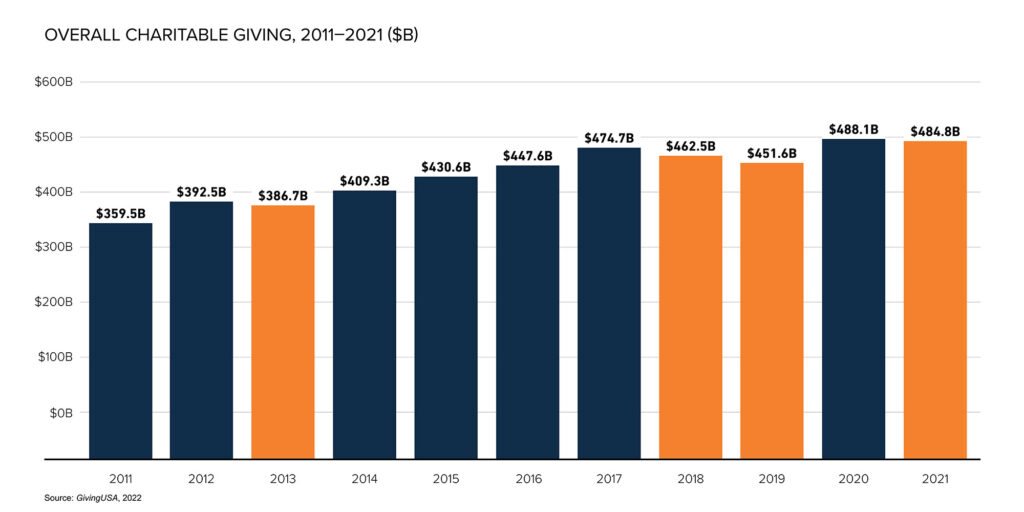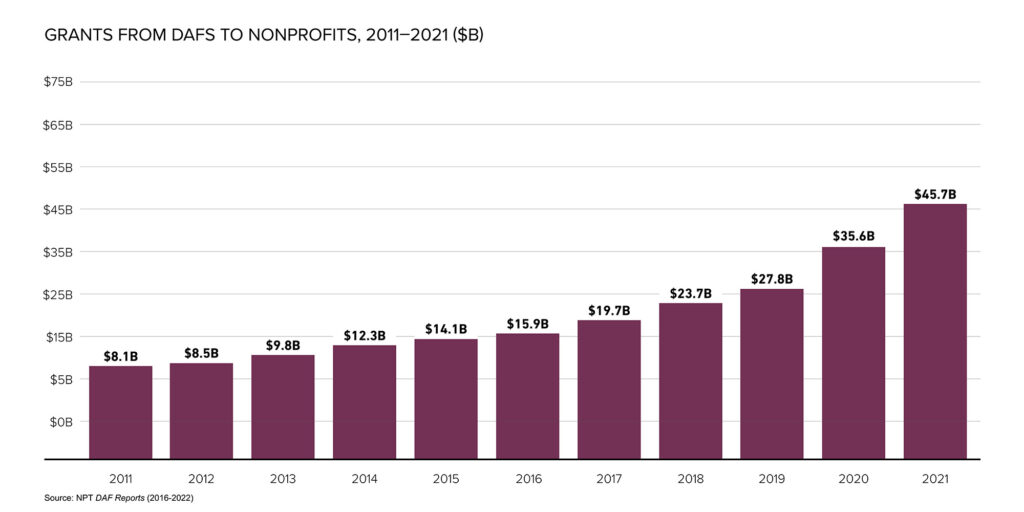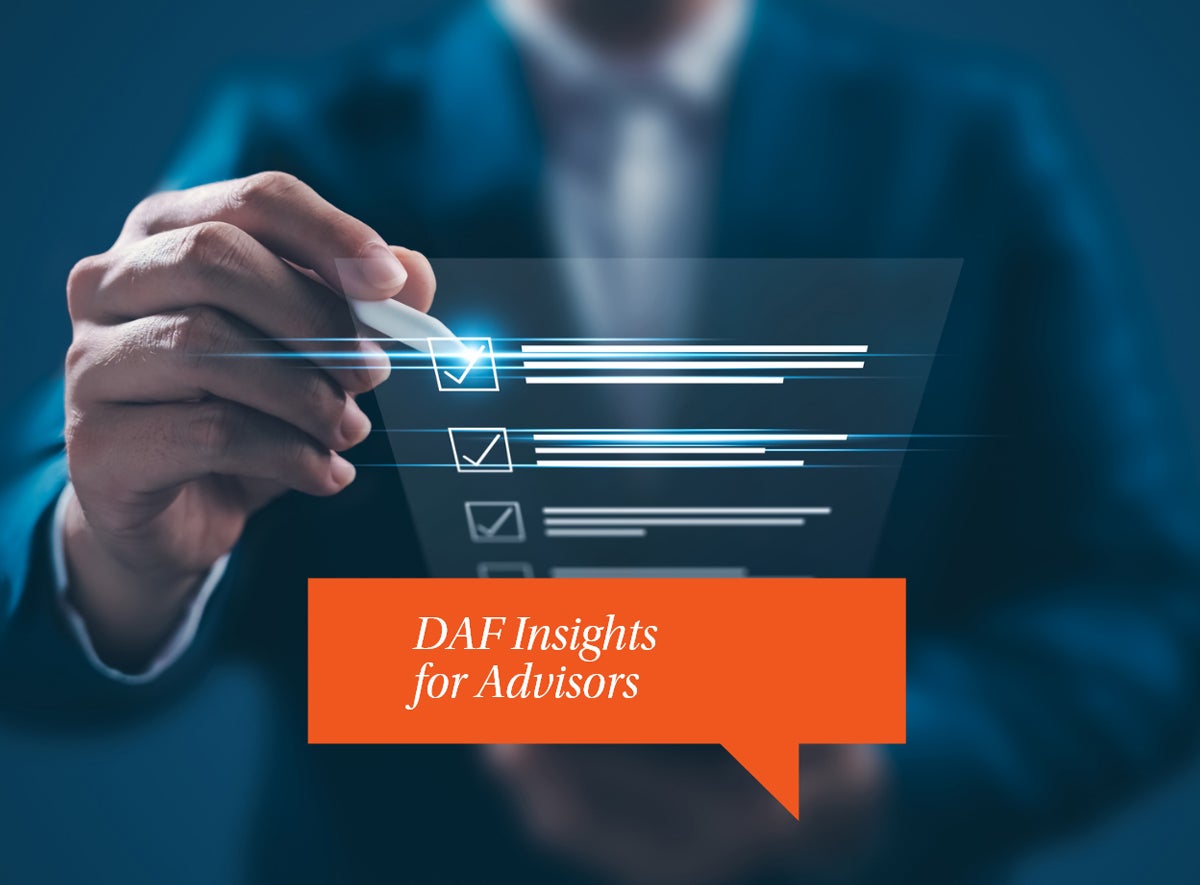How Donor-Advised Funds Can Provide Crucial Stability for Nonprofits During Economic Uncertainty

Although charitable giving generally tracks with larger economic cycles, donors who use donor-advised funds (DAFs) have a special advantage during economic downturns. Historically, grantmaking from DAFs remains robust, even during disruptive events. Last year donor-advised fund donors provided more than $45 billion to the nonprofit sector, serving frontline human services organizations, schools, houses of worship and more.
Since 2011, Americans’ overall charitable giving has declined four times, but dollars granted from DAFs have increased every year. DAFs help ensure that shortfalls in overall giving aren’t as severe and pick up the slack when times are harder. Because donors have pre-committed their charitable dollars, they are more able to separate the taxable and charitable considerations that go into philanthropic giving and focus on the impact they want their grantmaking to have. DAF donors have stepped up during crises like the 2007-2009 Great Recession, and in the thick of the COVID-19 pandemic, DAF grantmaking grew at its fastest rate on record.


As 2023 continues, economists and other forecasters are predicting turbulence. There’s no telling what the year will bring, but it is worth knowing that many nonprofits have already been weathering historic inflation over the past year. A broader economic downturn in 2023 would present additional hardship across the charitable sector.
But there are things you can do now to prepare. There’s an opportunity for donors, their advisors and the nonprofits they care about to prepare and build in the flexibility and resilience they’ll need. Below, we’ve assembled guidance from across NPT for the year ahead.
Guidance for Donors
Think About Charitable Need
The bind that many charities find themselves in, especially frontline human service organizations like shelters and food banks, is that during economic downturns demand for their services increases at exactly the same time that fundraising supply lags. But pre-committed charitable capital, like that held in DAFs and at private foundations, helps provide stabilization in moments like this—for their part, NPT’s donors supported human services organizations last year with $1.5 billion.
During the COVID-19 crisis, donors shifted dollars and committed new funds to frontline groups. Remember to look local for smaller or newer nonprofits, many of whom cannot rely on endowments or emergency funds. This might even be the right moment to make a transformative grant and help local organizations create these kind of strategic reserves for future crises.
Review Your Philanthropic Strategy
A new year is an opportunity to take stock of household finances, personal goals and philanthropic strategy. You can set an aspirational (or more realistic) philanthropic budget for the year ahead, broaden your scope or narrow in on a few specific causes and rebalance your priorities based on your own situation. Unrestricted and general operating funds are crucial for nonprofit flexibility, so consider the advantages of trust-based philanthropy in 2023.
Remember, too, the unique opportunity that invested DAF assets offer. Contributions from years ago may now have generated enough growth to offer a sizable grantmaking opportunity or fund a multi-year, recurring commitment.
Guidance for Nonprofits
Retention
The “dollars up, donors down” phenomenon continues; while more money is reaching nonprofits than ever before, fewer donors are contributing that money. For fundraisers, this will mean a both/and approach in 2023: it will still be important to broaden support, and bring in new, grassroots donors, but it’s essential to nurture, retain and reengage your major supporters. This is, of course, business as usual for nonprofit development teams, but all the more important and urgent during difficult economic times.
Partner with DAF Donors
Remember that charitable capital in DAFs is pre-committed and irrevocable. Donors who support your organization with an annual check may also have additional charitable funds available in a DAF. Likewise, donors who historically give through their DAF may have other resources available to make an additional contribution. There are more DAF donors than ever—at our last count the number of DAF accounts had surpassed 1 million—and often, DAF donors are the donors you already have. Be sure to include clear instructions and information that make granting from a DAF easy, like your organization’s EIN, in solicitation materials.
Guidance for Advisors
Think About Long-Term Charitable Planning
Economic uncertainty extends to charitable giving. Clients may be more hesitant to give, or create new accounts, but it’s worth reminding them that creating and contributing to a DAF is a charitable investment, and part of their long-term philanthropic vision and legacy. Because clients are thinking about navigating an uncertain market, there’s also room for conversations around investment strategy. There will be opportunities in the coming year to meet with your clients about reviewing their investment allocations not just for this year, but for a lifetime of charitable commitments.
Contribution-wise, encourage clients to take a longer-term view and look at appreciated assets that have gained in value over longer periods—three years of appreciation, five years or more. Those assets could fuel a transformative grantmaking opportunity at just the right moment over the coming year. Nonprofits are going to need extra help in a rocky economy, and now is a good time to focus on philanthropic strategy and grantmaking.
Looking Ahead
Remember that regardless of economic circumstances, your clients’ financial and personal lives continue. Businesses and wealth will change hands, long-deserved retirements will arrive, and the universe of tax events will not stop spinning. Philanthropy and charitable giving are bigger parts of those processes than ever before, so don’t hesitate to discuss the charitable dimensions and opportunities that come in tandem with major financial events.
Whatever the year brings, know that NPT will remain your partner in giving. Please reach out to us with any questions. NPT remains ready to help you help others.
NPT is not affiliated with any of the organizations described herein, and the inclusion of any organization in this material should not be considered an endorsement by NPT of such organization, or its services or products.
NPT does not provide legal or tax advice. This blog post is for informational purposes only and is not intended to be, and shall not be relied upon as, legal or tax advice. The applicability of information contained here may vary depending on individual circumstances.


